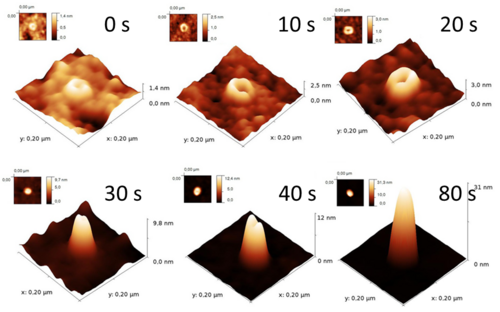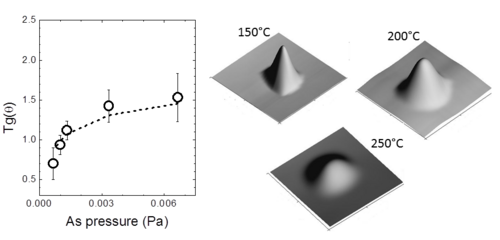| Search for content and authors |
Growth Dynamics of GaAs/AlGaAs Quantum dots by Droplet Epitaxy |
| Stefano Sanguinetti 1, Sergio Bietti 1, Claudio Somaschini 1, Alexey Fedorov 2 |
|
1. LNESS and Dipartimento di Scienza dei Materiali, Università di Milano-Bicocca, via Cozzi 53, Milano 20125, Italy |
| Abstract |
Droplet epitaxy (DE) [1] is an emerging and powerful MBE growth technique alternative to the commonly used Stranski-Krastanov approach for the self-assembly of quantum dots (QDs). Strain-free GaAs quantum dots can be grown by DE crystallizing group III metallic atoms, stored in nanometer scale droplets, with a group V atomic flux. This allows for an independent control over size and density of the fabricated QDs. However, despite the high level of design control achieved by DE, the details of the growth kinetics of the DE-QDs is still unclear. This knowledge could be of the utmost importance for the optimization of the fabrication procedures of DE-QD materials. Two fundamental aspects of the QD growth kinetics by DE will be here presented: 1) The crystallization kinetics of a nanometer size Ga droplet in to a QD under As flux 2) The faceting of a DE-QD and its dependence on the growth parameters The crystallization kinetics of the metallic Ga contained in the droplet into GaAs nanocrystals under the As flux is followed step-by-step, investigating the amount and the morphology of the crystallized GaAs in the droplet at different As doses by means of a combination of selective wet chemical etching and Atomic Force Microscopy (AFM), in a nano-tomography approach (see Figure 1). The crystallization of the Ga in the droplet starts from a ring of GaAs which is formed just after the Ga deposition at the perimeter of the droplet. This ring acts as nucleation seed for the subsequent QD growth. During the As supply, the ring increases its size at the expenses of the metallic droplet. The QD growth the proceeds at the contact surface between the liquid Ga and the ring until the complete depletion of the Ga contained in the droplet. The control of the faceting of DE-QD is a fundamental aspect for the fabrication of QDs with on-demand density of states and a reduced electron-phonon interaction. We will show that it is possible to determine, by the control of the crystallization kinetic, the shape of DE-QDs. The QD shape depends on the Ga diffusion length in the crystallization condition, thus showing a marked dependence on As pressure and temperature (see Figure 2). The facet orientation evolves, by reducing As pressure or increasing substrate temperature, from {111} facets, exposed at low temperatures and high As presure, towards {311} facets. A model, based on the effect of the diffusion of the metallic Ga from the droplet during the crystallization step, is able to reproduce the observed faceting evolution on temperature and As pressure. [1] N. Koguchi, S. Takahashi, T. Chikyow, J. Crystal Growth 111 (1991) 688. 
Figure 1: From left to right: crystallized GaAs morphology at different As irradiation times. The unreacted Ga in the droplet was removed by wet chemical etching.  Figure 2. Left panel: Dependence of DE-QD facet orientation on As crystallization pressure at TSUBST= 200 °C. θ is the angle between the substrate and the QD facet. The dashed line report simulation prediction based on Ga diffusion model. Right panel: AFM images of DE-QDs crystallized at different temperatures Figure 2. Left panel: Dependence of DE-QD facet orientation on As crystallization pressure at TSUBST= 200 °C. θ is the angle between the substrate and the QD facet. The dashed line report simulation prediction based on Ga diffusion model. Right panel: AFM images of DE-QDs crystallized at different temperatures |
| Legal notice |
|
| Related papers |
Presentation: Oral at 17th International Conference on Crystal Growth and Epitaxy - ICCGE-17, General Session 8, by Stefano SanguinettiSee On-line Journal of 17th International Conference on Crystal Growth and Epitaxy - ICCGE-17 Submitted: 2013-04-15 22:50 Revised: 2013-07-17 12:15 |